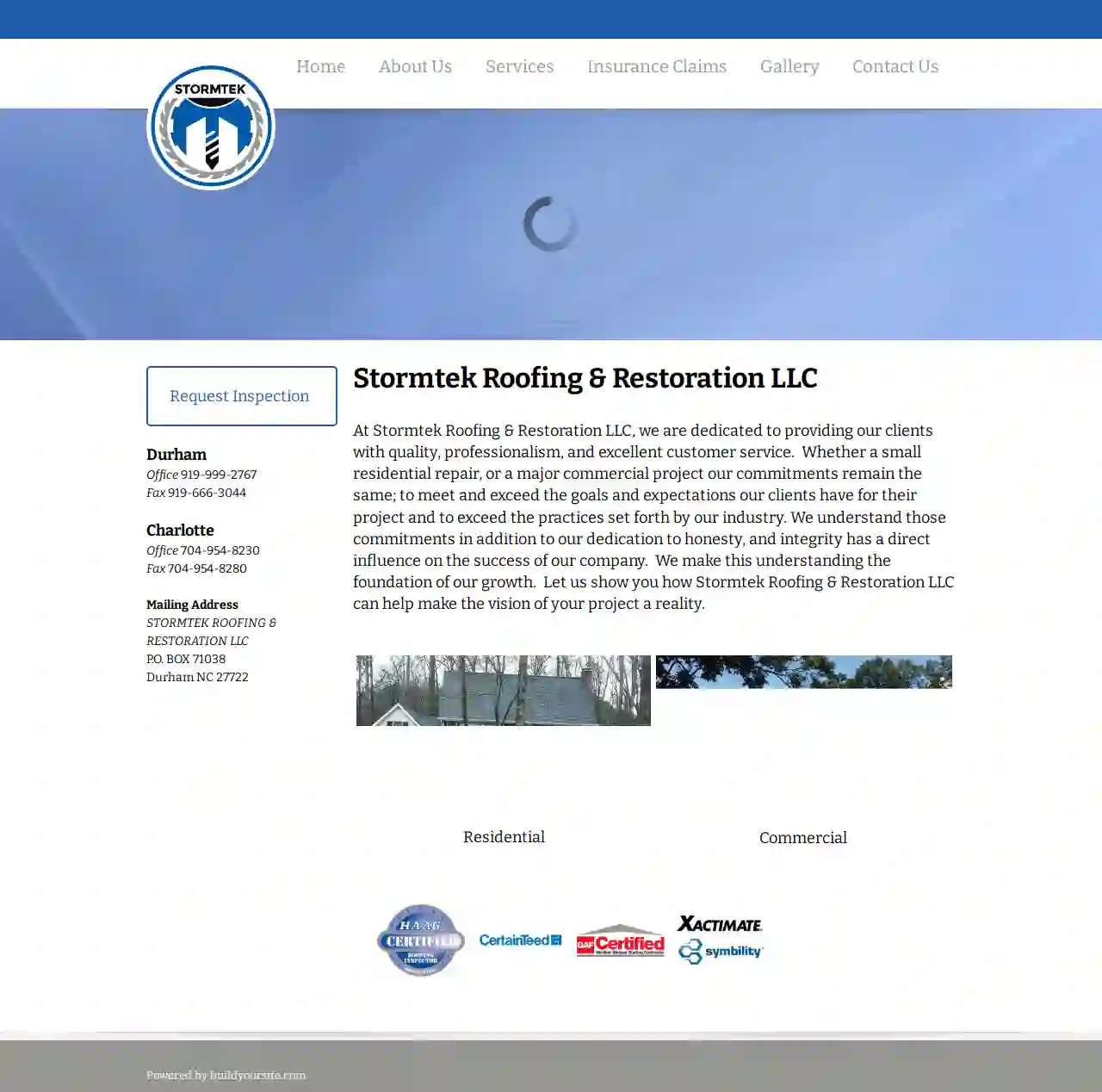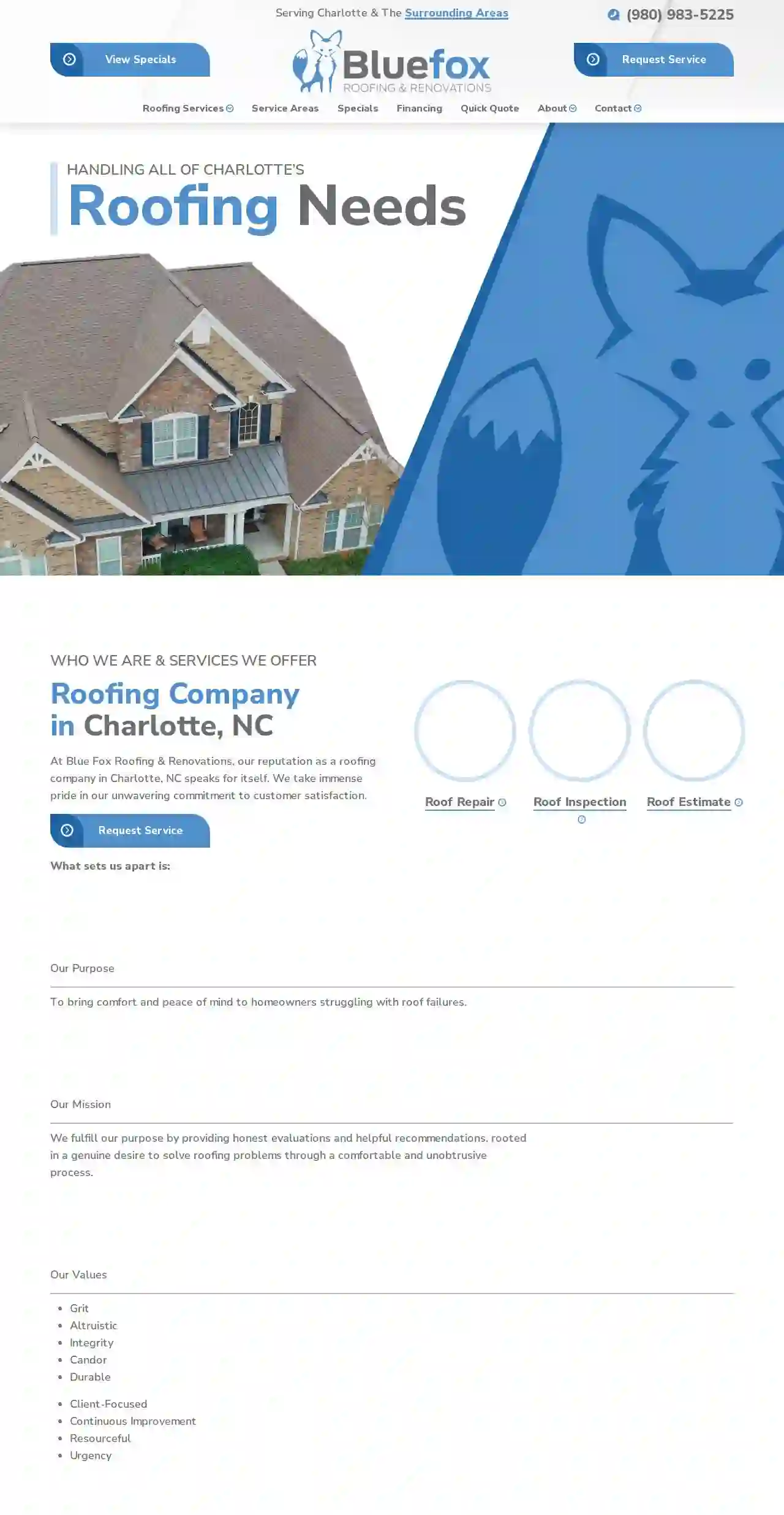Roofing Companies High Point
Best Roofing Companies in High Point
Receive 3 FREE Roofing Companies quotes for your project today! Compare profiles, reviews, accreditations, portfolio, etc... and choose the best deal.

American Roofing & Construction LLC
4.630 reviewsRaleigh, USAMERICAN ROOFING & CONSTRUCTION, LLC Exemplary Roofing & Construction Solutions at Your Service. American Roofing & Construction, LLC has been in business for almost 17 years providing homeowners and commercial businesses the quality of work they deserve. Our staff is professionally trained, reliable, and effective. We pride ourselves on providing the best materials, labor, and workmanship. We value our residential and commercial customers. We determine the best solution for your home or property and explain each step in the installation or repair process. We complete our job quickly and in the most unobtrusive manner for an affordable rate.
- Services
- Why Us?
- Gallery
Get Quote
STORMTEK ROOFING & RESTORATION LLC
52 reviewsP.O. BOX 71038, Durham, 27722, USAt Stormtek Roofing & Restoration LLC, we are dedicated to providing our clients with quality, professionalism, and excellent customer service. Whether a small residential repair, or a major commercial project our commitments remain the same; to meet and exceed the goals and expectations our clients have for their project and to exceed the practices set forth by our industry. We understand those commitments in addition to our dedication to honesty, and integrity has a direct influence on the success of our company. We make this understanding the foundation of our growth. Let us show you how Stormtek Roofing & Restoration LLC can help make the vision of your project a reality.
- Services
- Why Us?
- Gallery
Get Quote
N2 Builders
56 reviewsDurham, NC, 27705, USAt N2 Builders, we offer quality craftsmanship and superior service at fair and honest prices. We are a full-service roofing company located in Durham, NC. We serve a wide variety of residential and commercial clients. Our number one goal is to make sure that your home or building has a high quality roof that exceeds all expectations. For over 10 years, N2 Builders has provided professional, thorough and reliable roofing services to both homeowners and businesses in the local community. Our commitment to customer satisfaction has made us the top roofing company in the area. With over 20 years of experience, we specialize in all roofing types and offer a 100% satisfaction guarantee on all the work we do. If you're looking for a roofer you can count on to get the job done the right way, the first time, give us a call today.
- Services
- Why Us?
- Our Team
- Gallery
Get Quote
Proformance Roofing
5155 reviewsUnit 110, 3455 WD Judge Dr, Orlando, 32808, USAt ProFormance Roofing, we understand the importance of a quality roof for the protection and safety of your home and family. That's why we're considered Florida's premier roofing experts, committed to providing top-notch roofing solutions for Floridians. We specialize in a wide range of roofing services, including new roof installations and roof replacements. Protect Your Home's Most Valuable Asset with Our Lifetime Product Warranty. Our Premium Warranty is available exclusively to ProFormance customers. We offer an enhanced warranty that is a combination of the manufacturer's material warranty and the ProFormance workmanship warranty; you get quality name-brand products and a warrantied installation.
- Services
- Why Us?
- Accreditations
- Gallery
Get Quote
Cole Roofing & Construction
4.8264 reviews8801 Fast Park Drive Suite 301, Raleigh, 27617, USSince 1973, Cole Roofing & Construction has provided homeowners with high-quality home repair services throughout the Triangle area. Our roofers have more than 11,000 satisfied customers throughout the state of North Carolina, and we’ve grown to become one of the region's most respected home repair companies. Our Durham roofing experts offer a wide variety of services, including: CertainTeed Certified Roofing Installation, Siding, Rotten Wood Replacement, Storm Damage, Leak Repairs, Window Replacement, Gutters & Gutter Guards, Painting. We are proud of our reputation for offering quality work at a fair price. The quality of our work can be seen in some of the most prestigious buildings in the state. Our teams have worked on North Carolina's Governor's Mansion, the North Carolina Museum of History, the North Carolina Legislative building, and several universities in the state.
- Services
- Why Us?
- Testimonials
- Gallery
Get Quote
Triad Installations Roofing Greensboro Winston Salem High Point Kernersville
4.8168 reviews5202 West Market Street, Greensboro, 27409, USTriad Installations is a local business that has been serving the Triad area since 1984. We specialize in roofing, windows, vinyl siding, decks, and remodeling. Our team is committed to providing high-quality services and ensuring customer satisfaction. We offer financing options and have a team of experienced professionals who can help you with your project. We are a member of the National Association of Home Builders, Central Carolina Better Business Bureau, and other professional associations. We are also certified by various manufacturers and have a reputation for excellent workmanship and customer service.
- Services
- Why Us?
- Accreditations
- Our Team
- Gallery
Get Quote
Jackson Roofing LLC
521 reviewsRaleigh, USServing Raleigh, Wake Forest and surrounding areas. Locally owned On top of roofs since 1982! We apply decades of roofing experience to precisely assess the condition of your roof, determine next steps, and communicate this information to you as clearly and transparently as possible. We enjoy educating our clients on their specific options. Whether you know it’s time for a roof replacement or simply need a second opinion, allow us the opportunity to give you the truth about your roof!
- Services
- Why Us?
- Gallery
Get Quote
The Roof Genie
52 reviewsSebastian FL, Not Specified, Sebastian, 32976-7665, USThe Roof Genie is a leading local roofing company dedicated to providing a comprehensive range of roofing services characterized by quality, innovation, and expertise. With years of experience, they have built a strong reputation for masterful craftsmanship and committed customer service, consistently exceeding client expectations. They pride themselves on their team of industry experts who combine a deep understanding of the field with rigorous training, education, and experience. This expertise translates into superior service, efficient workmanship, and exceptional results on every project. The Roof Genie is committed to delivering smart solutions that save clients time and money while adhering to strict quality control standards. They offer a complete suite of services, from new construction and roof replacements to repairs, preventative maintenance, and inspections. Their consultative approach ensures personalized service tailored to each client's unique needs and specifications. The Roof Genie guarantees on-time service, a trained and qualified crew, fast turnarounds, extended warranties, and money-saving solutions.
- Services
- Why Us?
- Accreditations
- Our Team
- Testimonials
- Gallery
Get Quote
Koala Roofing & Solar
4.860 reviewsDurham, USKoala Roofing is a locally owned and operated company that has been providing its clients with the best roofing services. We have never failed to serve you with unmatched quality by maintaining high working standards.
- Services
- Why Us?
- Our Team
- Testimonials
- Gallery
Get Quote
Blue Fox Roofing & Renovations
5259 reviewsCharlotte, USAt Blue Fox Roofing & Renovations, our reputation as a roofing company in Charlotte, NC speaks for itself. We take immense pride in our unwavering commitment to customer satisfaction. We're here to provide responsive solutions for all your roofing needs. Our experienced roofing company specializes in roofing services ensuring that your roof receives the utmost care and attention it deserves. We excel in every aspect, effectively prolonging the lifespan of your roof and safeguarding your home, whether it's installation, repair, maintenance, or replacement. Our dedicated team will deliver top-notch workmanship and lasting quality. We place safety and your complete satisfaction at the forefront of our processes. We're not just a roofing contractor; we're your trusted partner in maintaining the integrity and longevity of your roof.
- Services
- Why Us?
- Accreditations
- Gallery
Get Quote
Over 17,196+ Roofers in our network
Our roofing experts operate in High Point & surroundings!
Roofyng.com has curated and vetted Top Roofing Companies in and around High Point. Find a reliable pro today.
Frequently Asked Questions About Roofing Companies
- Ventilation: Soffit vents provide intake ventilation, allowing fresh air to enter the attic and regulate temperature and moisture.
- Aesthetics: It creates a finished look to the roof's underside.
- Pest Control: A properly sealed soffit prevents pests like birds and squirrels from nesting in the attic.
- Choose Reflective Roofing Materials: Opt for light-colored shingles or metal roofing that reflects sunlight and reduces heat absorption.
- Install Proper Attic Insulation: Adequate insulation prevents heat loss in the winter and heat gain in the summer.
- Ensure Adequate Ventilation: Proper attic ventilation allows hot air to escape, reducing cooling costs and extending the lifespan of your roof.
- Consider a Radiant Barrier: In hot climates, a radiant barrier installed in the attic can reflect heat away from the roof, further reducing cooling needs.
- Experience: 'How long have you been in business, and what experience do you have with similar projects?'
- Licensing and insurance: 'Are you licensed and insured, and can I see proof of coverage?'
- Warranties: 'What warranties do you offer on your work and the materials used?'
- References: 'Can you provide references from past clients?'
- Project Timeline: 'What is the estimated timeline for completing the project?'
- Payment Terms: 'What are your payment terms, and do you require a deposit?'
- Communication: 'How will you keep me updated on the project's progress?'
- Cleanup: 'What steps will you take to protect my property during the project and ensure proper cleanup afterward?'
What is a roof valley, and why is it important?
What is a soffit, and why is it important for my roof?
How can I make my new roof more energy-efficient?
What questions should I ask a roofing contractor?
What is a roof valley, and why is it important?
What is a soffit, and why is it important for my roof?
- Ventilation: Soffit vents provide intake ventilation, allowing fresh air to enter the attic and regulate temperature and moisture.
- Aesthetics: It creates a finished look to the roof's underside.
- Pest Control: A properly sealed soffit prevents pests like birds and squirrels from nesting in the attic.
How can I make my new roof more energy-efficient?
- Choose Reflective Roofing Materials: Opt for light-colored shingles or metal roofing that reflects sunlight and reduces heat absorption.
- Install Proper Attic Insulation: Adequate insulation prevents heat loss in the winter and heat gain in the summer.
- Ensure Adequate Ventilation: Proper attic ventilation allows hot air to escape, reducing cooling costs and extending the lifespan of your roof.
- Consider a Radiant Barrier: In hot climates, a radiant barrier installed in the attic can reflect heat away from the roof, further reducing cooling needs.
What questions should I ask a roofing contractor?
- Experience: 'How long have you been in business, and what experience do you have with similar projects?'
- Licensing and insurance: 'Are you licensed and insured, and can I see proof of coverage?'
- Warranties: 'What warranties do you offer on your work and the materials used?'
- References: 'Can you provide references from past clients?'
- Project Timeline: 'What is the estimated timeline for completing the project?'
- Payment Terms: 'What are your payment terms, and do you require a deposit?'
- Communication: 'How will you keep me updated on the project's progress?'
- Cleanup: 'What steps will you take to protect my property during the project and ensure proper cleanup afterward?'